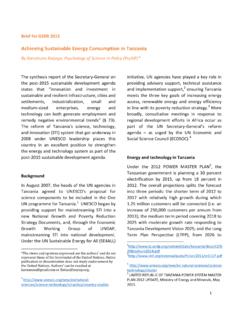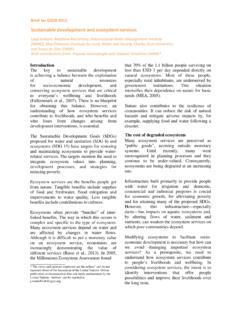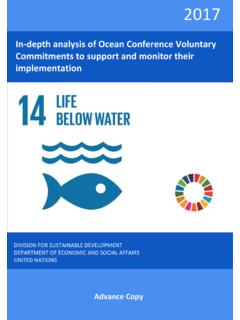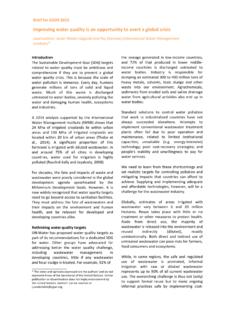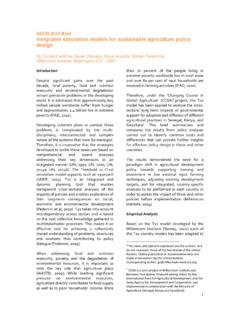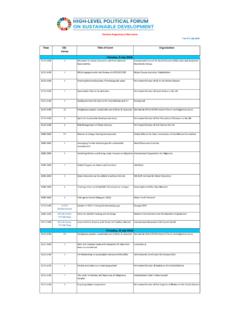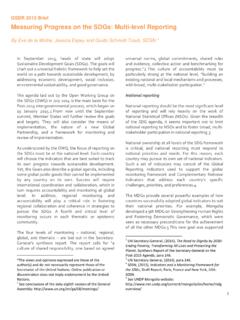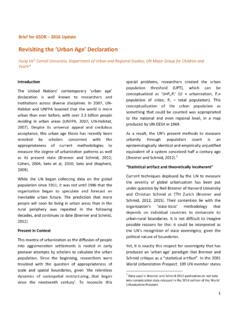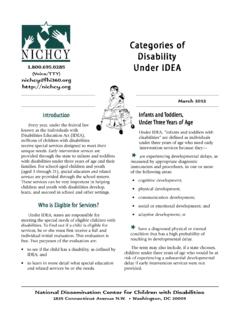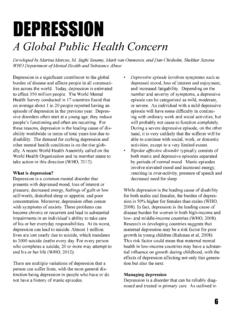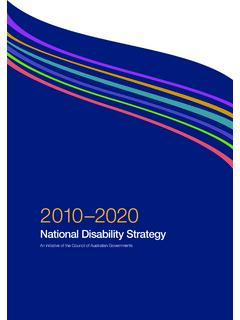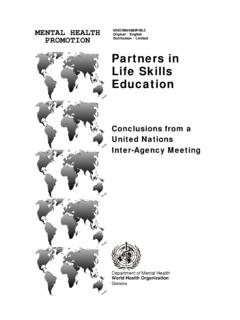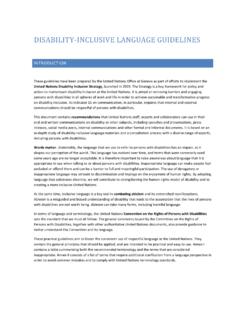Transcription of Final list of proposed Sustainable Development Goal indicators
1 Final list of proposed Sustainable Development Goal indicators The following global indicator framework was developed by the Inter-Agency and Expert Group on SDG indicators (IAEG-SDGs) and agreed to, as a practical starting point at the 47th session of the UN Statistical Commission held in March 2016. The report of the Commission, which included the global indicator framework, was then taken note of by ECOSOC at its 70th session in June 2016. The global indicator list is contained in the Report of the Inter-Agency and Expert Group on Sustainable Development Goal indicators ( ), Annex IV and provided below.
2 The list includes 230 indicators on which general agreement has been reached. Please note that the total number of indicators listed in the Final indicator proposal is 241. However, since nine indicators repeat under two or three different targets (see below), the actual total number of individual indicators in the list is 230. indicators in the Final list that repeat are the following: 1) 2) 3) 4) 5) 6) 7) 8) 9) Report of the Inter-Agency and Expert Group on Sustainable Development Goal indicators ( ) 2/25 Annex IV Final list of proposed Sustainable Development Goal indicators * Sustainable Development Goal indicators should be disaggregated, where relevant, by income, sex, age, race, ethnicity, migratory status, disability and geographic location, or other characteristics, in accordance with the Fundamental Principles of Official Statistics (General Assembly resolution 68/261).
3 Goals and targets (from the 2030 Agenda) indicators Goal 1. End poverty in all its forms everywhere By 2030, eradicate extreme poverty for all people everywhere, currently measured as people living on less than $ a day Proportion of population below the international poverty line, by sex, age, employment status and geographical location (urban/rural) By 2030, reduce at least by half the proportion of men, women and children of all ages living in poverty in all its dimensions according to national definitions Proportion of population living below the national poverty line, by sex and age Proportion of men, women and children of all ages living in poverty in all its dimensions according to national definitions Implement nationally appropriate social protection systems and measures for all, including floors.
4 And by 2030 achieve substantial coverage of the poor and the vulnerable Proportion of population covered by social protection floors/systems, by sex, distinguishing children, unemployed persons, older persons, persons with disabilities, pregnant women, newborns, work-injury victims and the poor and the vulnerable By 2030, ensure that all men and women, in particular the poor and the vulnerable, have equal rights to economic resources, as well as access to basic services, ownership and control over land and other forms of property, inheritance, natural resources, appropriate new technology and financial services, including Proportion of population living in households with access to basic services Proportion of total adult population with secure tenure rights to land, with legally recognized documentation and who perceive their rights to land as secure, by sex and by type of tenure By 2030, build the resilience of the poor and those in vulnerable situations and reduce their exposure and vulnerability to climate-related extreme events and other economic, social and environmental shocks and disasters Number of deaths.
5 Missing persons and persons affected by disaster per 100,000 peoplea Direct disaster economic loss in relation to global gross domestic product (GDP)a Number of countries with national and local disaster risk reduction strategiesa _____ a An open-ended intergovernmental expert working group on indicators and terminology relating to disaster risk reduction established by the General Assembly (resolution 69/284) is developing a set of indicators to measure global progress in the implementation of the Sendai Framework. These indicators will eventually reflect the agreements on the Sendai Framework indicators .
6 Report of the Inter-Agency and Expert Group on Sustainable Development Goal indicators ( ) 3/25 Goals and targets (from the 2030 Agenda) indicators Ensure significant mobilization of resources from a variety of sources, including through enhanced Development cooperation, in order to provide adequate and predictable means for developing countries, in particular least developed countries, to implement programmes and policies to end poverty in all its dimensions Proportion of resources allocated by the government directly to poverty reduction programmes Proportion of total government spending on essential services (education, health and social protection)
7 Create sound policy frameworks at the national, regional and international levels, based on pro-poor and gender-sensitive Development strategies, to support accelerated investment in poverty eradication actions Proportion of government recurrent and capital spending to sectors that disproportionately benefit women, the poor and vulnerable groups Goal 2. End hunger, achieve food security and improved nutrition and promote Sustainable agriculture By 2030, end hunger and ensure access by all people, in particular the poor and people in vulnerable situations, including infants, to safe, nutritious and sufficient food all year round Prevalence of undernourishment Prevalence of moderate or severe food insecurity in the population, based on the Food Insecurity Experience Scale (FIES)
8 By 2030, end all forms of malnutrition, including achieving, by 2025, the internationally agreed targets on stunting and wasting in children under 5 years of age, and address the nutritional needs of adolescent girls, pregnant and lactating women and older persons Prevalence of stunting (height for age <-2 standard deviation from the median of the World Health Organization (WHO) Child Growth Standards) among children under 5 years of age Prevalence of malnutrition (weight for height >+2 or <-2 standard deviation from the median of the WHO Child Growth Standards) among children under 5 years of age, by type (wasting and overweight)
9 By 2030, double the agricultural productivity and incomes of small-scale food producers, in particular women, indigenous peoples, family farmers, pastoralists and fishers, including through secure and equal access to land, other productive resources and inputs, knowledge, financial services, markets and opportunities for value addition and non-farm employment Volume of production per labour unit by classes of farming/pastoral/forestry enterprise size Average income of small-scale food producers, by sex and indigenous status By 2030, ensure Sustainable food production systems and implement resilient agricultural practices that increase productivity and production, that help maintain ecosystems, that strengthen capacity for adaptation to climate change, extreme weather, drought, flooding and other disasters and that progressively improve land and soil quality Proportion of agricultural area under productive and Sustainable agriculture Report of the Inter-Agency and Expert Group on Sustainable Development Goal indicators ( ) 4/25 Goals and targets (from the 2030 Agenda)
10 indicators By 2020, maintain the genetic diversity of seeds, cultivated plants and farmed and domesticated animals and their related wild species, including through soundly managed and diversified seed and plant banks at the national, regional and international levels, and promote access to and fair and equitable sharing of benefits arising from the utilization of genetic resources and associated traditional knowledge, as internationally agreed Number of plant and animal genetic resources for food and agriculture secured in either medium or long-term conservation facilities Proportion of local breeds classified as being at risk, not-at-risk or at unknown level of risk of extinction Increase investment, including through enhanced international cooperation, in rural infrastructure, agricultural research and extension services, technology Development and plant and livestock gene banks in order to enhance agricultural productive capacity in developing countries.

